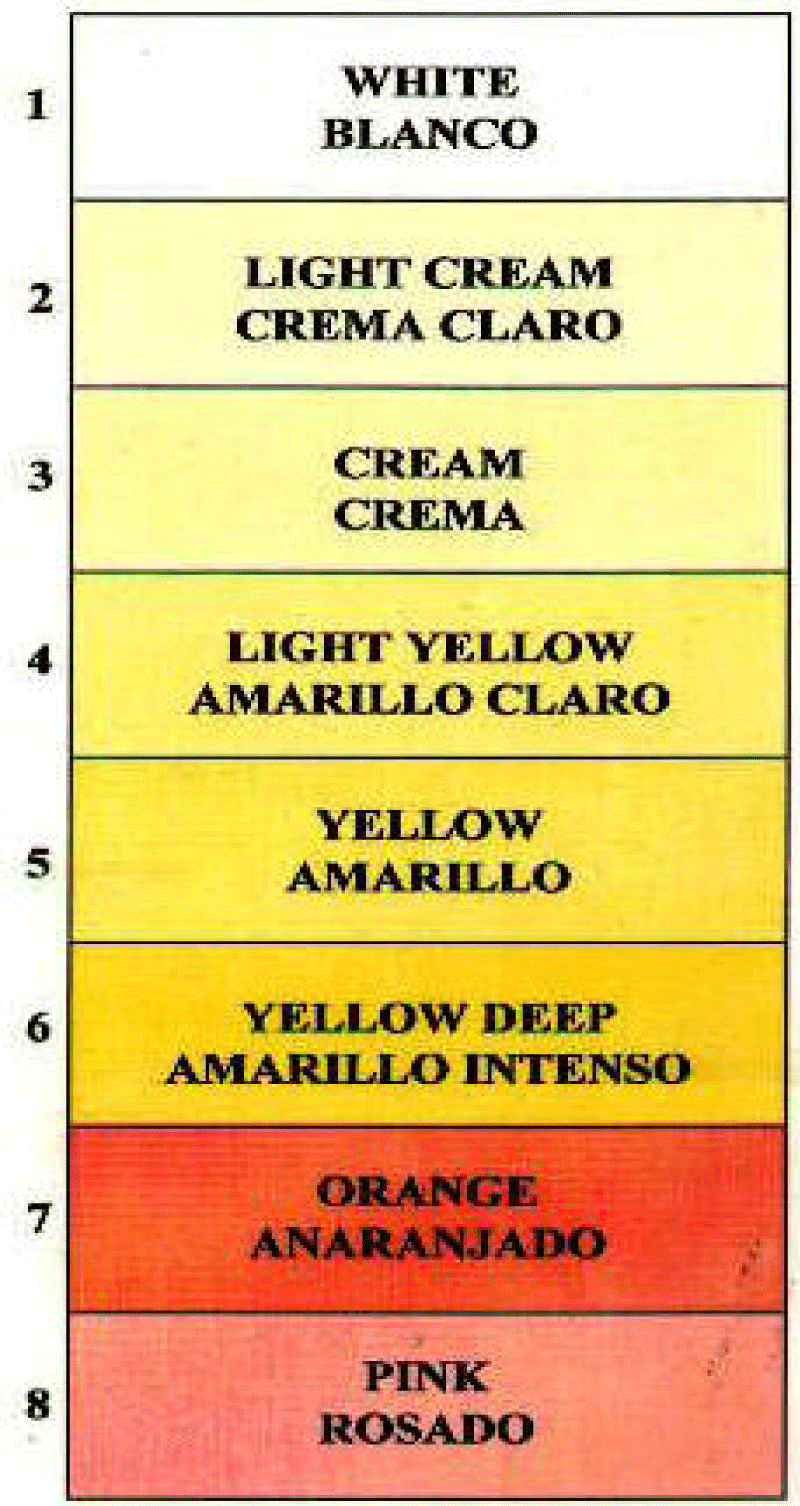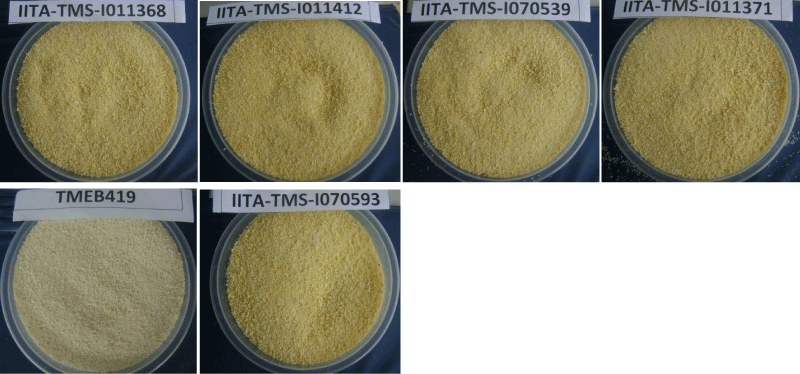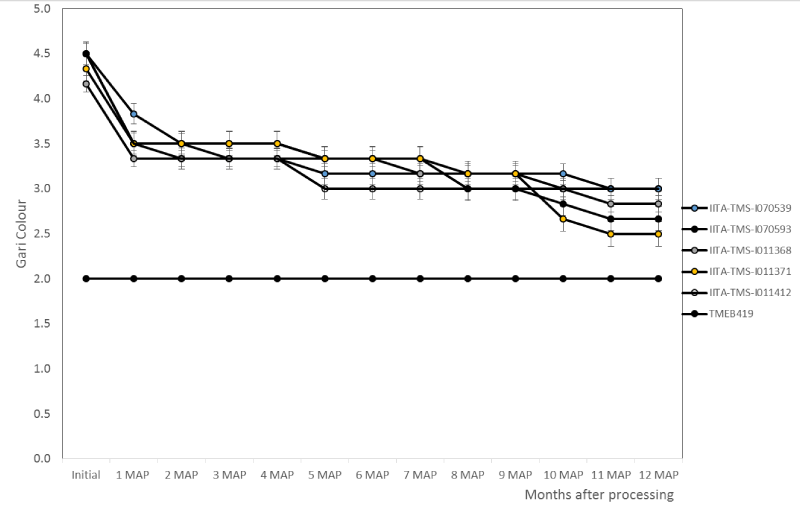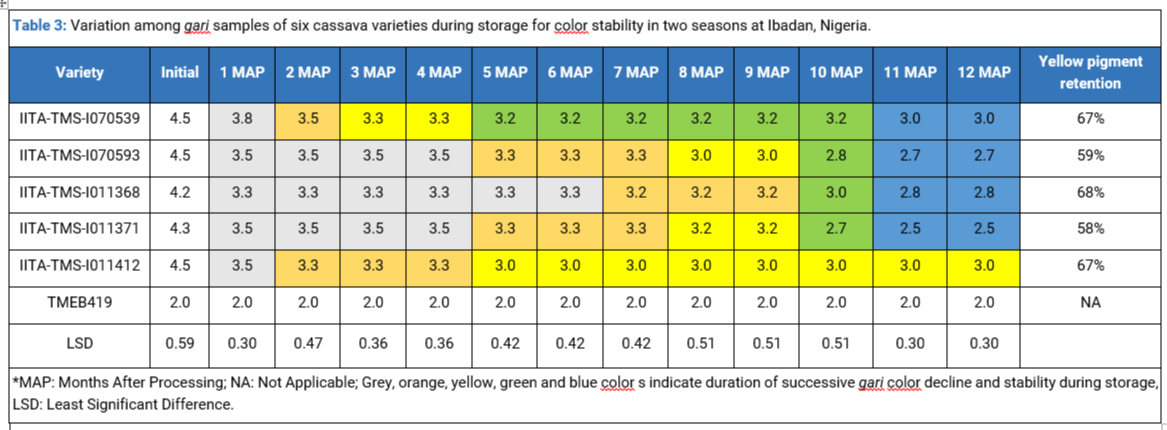Global Journal of Ecology
Variation among gari samples of some yellow cassava (Manihot esculenta Crantz) varieties for change in color during storage
Olasanmi B1, Udemba IO1* and Iluebbey P2
2International Institute of Tropical Agriculture, Ibadan, Oyo State, Nigeria
Cite this as
Olasanmi B, Udemba IO, Iluebbey P (2022) Variation among gari samples of some yellow cassava (Manihot esculenta Crantz) varieties for change in color during storage. Glob J Ecol 7(2): 125-129. DOI: 10.17352/gje.000073Copyright
© 2022 Olasanmi B, et al. This is an open-access article distributed under the terms of the Creative Commons Attribution License, which permits unrestricted use, distribution, and reproduction in any medium, provided the original author and source are credited.Carotenoids in bio-fortified gari are degraded by light and oxidation during storage resulting in fading of their yellow color. In this study, gari from yellow-root (bio-fortified) cassava varieties (YCVs) were evaluated for color change during storage in two seasons. About 400 g of fresh gari samples of five YCVs (IITA-TMSI011368, IITA-TMSI011371, IITA-TMSI011412, IITA-TMSI070539 and IITA-TMS-I070593) and white-root variety (TMEB419-check) were packaged in transparent plastics to ensure exposure to light. The samples were evaluated monthly for color change using a chart with a scale of 1 (white) to 8 (pink) for 12 months in each season. Data collected were subjected to ANOVA, descriptive and correlation analyses. Reduction in yellow color intensity was observed among the yellow gari samples in the first month from average of 4.40 to 3.53 representing about 20% decrease. At 12 months after processing, varieties IITA-TMSI011368 and IITA-TMSI011371 had the highest (68%) and least (58%) yellow pigment retention, respectively. There was significant variation among the varieties for gari color change and yellow pigment retention over the storage period. Therefore, carotenoid content in bio-fortified gari depends on the cassava variety and storage period. These factors should be considered in future breeding program to improve cassava for carotenoid content.
Introduction
Cassava roots are predominantly carbohydrate dense [1], but contain little protein, fat, and some minerals and vitamins [2,3]. Therefore, cassava consumers have high chances of experiencing inadequate vitamin A intake [4]. This is sequel to the fact that the requirement for this vitamin can only be satisfied either by animal food products containing preformed Vitamin A or plant food products containing pro-vitamin A carotenoids [5,6]. Thus, bio-fortification of cassava with pro-vitamin A carotenoids can potentially reduce vitamin A deficiency in low-income countries [7] where cassava is a staple food.
Cassava is usually processed into variety of products including gari which accounts for about 70% of the total processed products obtained from cassava in West Africa [8-11].
gari constitutes a major part of the dietary intake of cassava products in Africa, Southeast Asia, and Brazil [12-16]. Millions of both rich and poor Nigerians have also adopted gari as a high energy staple food sequel to its availability all year round, long shelf-life and multiplicity of use [17]. Thus, being the highest consumed cassava product in Nigeria, gari will be a viable vehicle for the introduction of yellow cassava to the populace [18].
Carotenoids in plant are depicted by varying shades of yellow or orange color [19]. The intensity of the root color had been shown to be highly correlated with carotenoid content making it feasible to use color to estimate carotenoid content [15,20-23]. Njenga, et al. [24] reiterated that 98% of the variability in cassava carotenoid content can be explained by the variability in root color. The gari produced from bio-fortified yellow root cassava varieties is very similar in color to gari made with added crude palm oil [25] and rich in carotenoids thus making it a good and cheap source of vitamin A [26]. In addition, the yellow gari produced from yellow root cassava varieties may also have additional advantage over the one from white root varieties (with palm oil added) in the area of uniformity of the yellow color and ability to store for longer period without going rancid.
Pro-vitamin A carotenoids (the predominant carotenoid present in bio-fortified yellow gari) are chemically unstable molecules that can be degraded during typical processing and storage due to the sensitivity of carotenoids to physical factors such as light, heat, oxygen, food enzymes or their interaction [27-29], hence, retention of carotenoids during processing and storage is still a challenge. Although UcheChukwu-Agua, et al. [10] asserted that packaging materials influenced the carotenoid retention and hence yellowness of stored bio-fortified cassava flour they evaluated, strong genotypic effect on level of retention of carotenoids in stored products was also reported by Bechoff, et al. [30]. Furthermore, Bechoff, et al. [15] elucidated that storage condition is a main determinant of the final characteristics and composition of cassava products.
Although the detrimental effect of light exposure on stored product quality had been reported [15,31-33], there is dearth of information in literature on the effect of exposure to light during long term storage on the color (measure of β-carotene content) of gari from newly released yellow cassava varieties in Nigeria [34]. Hence, the need to evaluate gari from these varieties for change in color (fading of yellow pigment) due to exposure to light during storage. The objective of this study was therefore to determine the effect of storage duration on color of bio-fortified gari exposed to light during storage.
Materials and methods
Fresh roots of five yellow cassava varieties (IITA-TMS-I011368, IITA-TMS-I011371, IITA-TMS-I011412, IITA-TMS-I070593 and IITA-TMS-I070539) and one white root variety (TMEB419) used as check were harvested at 12 months after planting from the experimental plot of Department of Crop and Horticultural Sciences, University of Ibadan in each season (2016 and 2017). About 10 kg of wholesome storage roots of each variety were selected from plots in the three replicates of the experiment. The storage roots from each replicate for each variety were processed into gari using the procedure described by James, et al. [35] within 24 hours of harvesting. About 400 g of each of the gari samples in three replicates was packaged in white transparent plastic container to ensure the gari was preserved from atmospheric moisture but exposed to light. The treatments were arranged on open shelf in the Crop Utilization Laboratory of Department of Crop and Horticultural Sciences, University of Ibadan using completely randomized design. The experiment was carried out in 2016 and repeated in 2017.
Due to the fact that carotenoids are denoted with yellow or orange pigments which contribute to the color of bio-fortified gari [36], the gari color was used as a measure of carotenoid level in the gari samples evaluated in this study. Hence, each gari sample was scored for color immediately after processing (initial sample color) and thereafter on monthly basis using a color chart (Figure 1) with a scale of 1-8 where 1 = white and 8 = pink [37] for a period of 12 months. During scoring, each gari sample was thoroughly mixed to ensure a representative sample was used for the scoring. Some of the gari sample was then placed on the color chart for scoring. The gari sample used for the scoring was returned to the container immediately to ensure the same volume of gari was stored in each container throughout the period of the experiment. The data collected were subjected to descriptive analysis using Microsoft excel and correlation analysis as well as analysis of variance using Statistical Analysis Software (Version 9.0). Significantly different means were separated using LSD at 5% level of probability.
Results
The gari samples (immediately after processing) of the six cassava varieties evaluated in this study for change in color during storage are shown in Figure 2. The color of the samples from the five yellow root varieties ranged from light yellow (score of 4) to yellow (score of 5) while that of the white root check variety was light cream in color (score of 2) and not white, just like the root tissue it was obtained from.
Variety, season, storage duration (period) and interaction among them had significant effect on changes in color of the stored gari samples (Table 1). The color scores of the five bio-fortified gari decreased with increase in storage duration across the two seasons with the color scores dropping sharply from average of 4.40 (4.2 - 4.5) to 3.53 (3.3 - 3.8) representing about 20% decrease in the total carotenoid content of the gari samples in the first month (Figure 3). Subsequently, the highest decrease in average color score was about 5% at 5, 10 and 11 months after processing (MAP) (Figure 3). gari sample from the check variety TMEB419 had significantly lower pigment color over the 12 months of storage (Figure 3). Significant variation was observed for the gari samples between initial stage and first MAP; fourth and fifth; ninth and tenth; and tenth and eleventh MAP across the two seasons (Table 2). Also, significant difference in color score was observed between gari of each of the YCVs and that of TME 419 from 1 to 12 MAP and among gari of the five YCVs at 1, 11 and 12 MAP (Table 3). gari sample of variety IITA-TMS-I011412 attained stability in carotenoid content (no further decrease in gari color) earlier (5 MAP) than gari of other four bio-fortified varieties which attained stability only at 11 MAP (Table 3). At 12 MAP, the least color score of 2.5 was observed in variety IITA-TMS-I01371 while the highest value of 3.0 was recorded in varieties IITA-TMS-I070539 and IITA-TMS-I01412 (Table 3). Over the 12 months of storage, the highest percentage yellow pigment (color) retention of 68% was recorded in variety IITA-TMS-I011368; IITA-TMS-I070539 and IITA-TMS-I011412 had 67% each while the least retention percentage of 58% was observed in variety IITA-TMS-I011371 (Table 3). It is noteworthy that these three varieties (IITA-TMS-I011368, IITA-TMS-I070539 and IITA-TMS-I011412) with high yellow pigment retention percentage also had higher pigment color score (ranging from 2.8 - 3.0) than the other two varieties at 12 MAP (Table 3). Correlation among the varieties for change in gari color over the storage period was positive and significant (Table 4).
Discussion
Degradation of carotenoids compounds resulting in loss of yellow color is a major challenge in maintaining the health benefits of high carotenoid products [38]. This is due to the vulnerability of double bond in carotenoids carbon chain to chemical reactions induced by oxygen, light and heat during processing or storage [39,40]. The varietal variation in gari color across the storage duration suggests that rate of loss of carotenoid in bio-fortified gari samples may not be uniform among the varieties over time. Sharp reduction in gari color at 1 MAP indicates that most of the losses due to exposure to light occurred within the first month after processing, hence, short time storage before consumption may not prevent substantial loss in carotenoid content of gari samples from yellow root cassava varieties due to exposure to light. These observations corroborate the previous submissions of some authors who reported highest carotenoid degradation of some stored bio-fortified cassava products after few weeks of storage [15,31,41].
The increase in yellow color fading of the stored bio-fortified yellow gari samples with increase in storage duration affirmed the previous submission of Oliviera, et al. [41] that oxidation process resulting in carotenoid degradation is not interrupted during storage. Hence, the observed yellow pigment degradation with increase in storage period. The report of UcheChukwu-Agua, et al. [10] also indicated that oxidation and degradation of yellow pigment in bio-fortified cassava is responsible for decline of yellowness of stored bio-fortified cassava products. The observed decrease in yellowness of the bio-fortified gari in this study, most especially within the first month, could be assumed to be equivalent to huge loss of carotenoids in the gari samples.
The record of higher yellow pigment color scores and pigment retention percentage from varieties IITA-TMS-I011368, IITATMS-I070539 and IITA-TMS-I011412 implies better stability of carotenoid in the gari from these three varieties after long term storage which should translate to better nutritional benefit for end users of such products. gari has been identified as one of the most popular cassava products consumed in Africa, Southeast Asia and Brazil [9,13,16,37,42] as over 70% of total cassava produced in West African countries including Nigeria is processed into 7 million - 10 million tonnes of gari annually. Efforts to ensure that the large population depending on gari in these regions get optimum benefit from the product can therefore not be overemphasized. Future breeding work to improve cassava for carotenoid content should put into consideration the retention percentage of the micronutrient in the products during storage, most especially when such products cannot be totally shielded from light. This is sequel to the fact that detrimental effect of exposure to light on quality of stored products had been reported [15,31-33] which was also validated in this investigation. The observations of significant effect of storage duration and variety on gari color change are in agreement with the submission of Uchechukwu-Agua, et al. [10] who attributed changes in yellow color of stored bio-fortified cassava flour to the length of storage and cultivar differences. Also, varietal influence on the carotenoid content of some stored bio-fortified cassava samples was reported in other previous studies [28,30,41]. The record of significantly lowest pigment color from gari sample from the check variety TMEB419 over the 12 months of storage suggests that end-users of gari from the yellow root varieties have access to more carotenoids regardless of the storage period within a year. The significant correlation observed among the varieties for change in gari color over the storage period indicates that the fading of yellow color of the gari samples (varieties) followed similar trend over time, hence, response of the gari samples to light exposure at a particular storage period could be reliably predicted using observations at other periods.
Conclusion
gari samples from five yellow and one white root cassava varieties were evaluated at Ibadan in 2016 and 2017 for fading in color (loss of carotenoid) over storage time of twelve months in each year. Continuous degradation of carotenoids (as depicted by yellow color depletion) was observed in all the bio-fortified gari samples from the yellow root varieties over the storage period with variety IITA-TMS-I011412 attaining stability about six months ahead of others. Loss of 32% to 42% of the yellow pigment color of the bio-fortified yellow gari observed in this study shows the need for laboratory quantification of carotenoid content in the stored gari over time to ascertain the actual loss. The observed rapid reduction in yellow pigment color of the bio-fortified gari samples in the first month of storage calls for the need to identify better storage methods to minimise loss of the micronutrients during storage. The information gathered in this study can be harnessed in future breeding programmes and storage processes to ensure that the amount of carotenoid available in bio-fortified gari is sufficient to meet the nutritional requirement of the consumers.
- Gil JL, Buitrago AJ. La Yuca En La Alimentacion Animal. In: Ospinab, Ceballosh, Editors. La Yuca En El Tercer Milenio: Sistemas Modernos De Producción, Procesamiento, Utilización Y Omercialización. Cali, Colombia :International Center for Tropical Agriculture. 2002; 527-569.
- Charles AL, Chang YH, Ko WC. Some physical and chemical properties of starch isolates of cassava genotypes. Starch/Starke. 2004; 56: 413–418.
- Montagnac JA, Davis CR, Tanumihardjo SA. Nutritional value of cassava for use mutant in cassava (Manihot esculenta Crantz). Journal of Agricultural and Food Chemistry. 2009; 56(16): 7215-7222.
- Gegios A, Amthor R, Maziya-Dixon B, Egesi C, Mallowa S, Nungo R, Gichuki S, Mbanaso A, Manary MJ. Children consuming cassava as a staple food are at risk for inadequate zinc, iron, and vitamin A intake. Plant Foods Hum Nutr. 2010 Mar;65(1):64-70. doi: 10.1007/s11130-010-0157-5. PMID: 20165984; PMCID: PMC2840668.
- Wardlaw GM, Hamp IJS, Disilvestro RA. Perspective in Nutrition. NewYork, USA: McGraw- Hall. 2004; 332.
- von Lintig J, Vogt K. Vitamin A formation in animals: molecular identification and functional characterization of carotene cleaving enzymes. J Nutr. 2004 Jan;134(1):251S-6S. doi: 10.1093/jn/134.1.251S. PMID: 14704329.
- Talsma EF, Melse-Boonstra A, de Kok BP, Mbera GN, Mwangi AM, Brouwer ID. Biofortified cassava with pro-vitamin A is sensory and culturally acceptable for consumption by primary school children in Kenya. PLoS One. 2013 Aug 30;8(8):e73433. doi: 10.1371/journal.pone.0073433. PMID: 24023681; PMCID: PMC3758265.
- Sanni LO, Adebowale AA, Awoyale W. Quality of gari (roasted cassava mash) in Lagos State, Nigeria. Nigerian Food Journal. 2008; 26(1): 125-134.
- Babatunde J. Reviving Nigeria’s economy through cassava plan In: Speech of Minister for Agriculture and Rural Development. Nigeria Vanguard Newspaper January 6. 2012.
- Uchechukwu-Agua AD, Caleb O, Manley M. Effects of storage conditions and duration on physicochemical and microbial quality of the flour of two cassava cultivars (TME 419 and UMUCASS 36). Journal of Food. 2015; 13(4): 635-645.
- Otekunrin OA, Sawicka B. Cassava a 21 century staple crop. How can Nigeria harness its enormous trade potentials. Acta Scientific Agriculture. 2019; 3(8): 194-202.
- Maziya-Dixon B, Dixon AG, Ssemakula G. Changes in total carotenoid content at different stages of traditional processing of yellow-fleshed cassava genotypes. International Journal of Food Science and Technology. 2009; 44(12): 235- 242.
- Karim OR, Fasasi OS, Oyeyinka SA. gari yield and chemical composition of cassava roots stored using traditional methods. Pakistan Journal of Nutrition. 2009; 8(12):1830-1833.
- Bamidele OP, Ogundele FG, Ojubanire BA, Fasogbon MB, Bello OW. Nutritional composition of "gari" analog produced from cassava (Manihot esculenta) and cocoyam (Colocasia esculenta) tuber. Food Sci Nutr. 2014 Nov;2(6):706-11. doi: 10.1002/fsn3.165. Epub 2014 Sep 2. PMID: 25493189; PMCID: PMC4256576.
- Ye Z, Xu YJ, Liu Y. Influence of different dietary oil consumption on nutrient malabsorption: An animal trial using Sprague Dawley rats. J Food Biochem. 2021 Apr;45(4):e13695. doi: 10.1111/jfbc.13695. Epub 2021 Mar 11. PMID: 33694208.
- Ola L, Rihana H, Siew N. Identification of aromatic componds and their sensory characteristics in cassava flakes and gari (Manihot esculenta Crantz). Journal of Food. 2016; 14(1):154-161
- Teye E, Amoah RS, Adu MO. Evaluation and developing simple techniques for assessing gari adulteration. Journal of Food Security. 2017; 5(5): 162-168.
- Onyemauwa CS. Analysis of household consumption of cassava products in Ohaozara, Ebonyi State, Southeast Nigeria. Researcher. 2010; 2(6):1-6.
- Adie PA, Okporie PJ, Obasi SC. Effect of packaging materials on total carotenoid content of palm-fruits and orange- flesh sweet potatoes during postharvest. International Journal of Science and Technology. 2017; 5(7): 63-70.
- Iglesias C, Mayer J, Chavez L. Genetic potential and stability of carotene content in cassava roots. Euphytica. 1997; 94: 367-373.
- Chavez AL, Bedoya JM, Sanchez T. Iron, carotene, and ascorbic acid in cassava roots and leaves. Food and Nutrition Bulletin. 2000; 21(4): 410-413.
- Ferreira CF, Alves E, Pestana KN. Molecular characterization of cassava (Manihot esculenta Crantz) with yellow-orange roots for beta-carotenoid improvement. Journal of Crop Breeding and Applied Biotechnology. 2008; 8: 23-29.
- Ceballos H, Morante N, Sánchez T. Rapid cycling recurrent selection for increased carotenoids content in cassava roots. Crop Science. 2013; 53: 2342–2351.
- Njenga PW, Edema R, Kamau JW. Variability in carotenoid content among introduced yellow-fleshed cassava clones. Second RUFORUM Biennial Meeting Entebbe, Uganda. 20 - 24 September 2010; 139-142.
- Abu J, Badifu G, Akpapunam M. Effect of crude palm oil inclusion on some physicochemical properties of gari a fermented cassava food product. Nigeria Food Journal. 2006; 24: 73-79.
- Nassar NM, Ortiz R. Cassava genetic resources manipulation for crop improvement. 2009; Plant breeding Reviews. 31: 247.
- Rodriguez-Amaya DB. Carotenoids and food preparation: the retention of provitamin A carotenoids in prepared, processed and stored foods. Washington DC, USA: USAID-OMNI. 1997; 1-93.
- Chávez AL, Sánchez T, Ceballos H. Retention of carotenoids in cassava roots submitted to different processing methods. Journal of the Science of Food and Agriculture. 2007; 87: 388–393.
- Maziya-Dixon B, Awoyale W, Dixon A. Effect of processing on the retention of total carotenoid, iron and zinc contents of yellow-fleshed cassava roots. Journal of Food and Nutrition Research. 2015; 3(8): 483-488.
- Bechoff A, Taleon V, Carvalho LM. Micronutrients (Provitamin A and Iron/Zinc) retention in bio-fortified crops. African Journal of Food Agriculture and Nutrition Development. 2017; 17(2): 11893-11904.
- Uzomah A, Ubbaonu CN, Osuji CM. Vitamin A retention in palm oil gari during processing and storage. NigeriaFood Journal. 2006; 23(1): 69-73.
- Callivo MM, Santa-maila G. Effect of illumination and chlorophyll on stability of tomatoes-carotenoids. Food Chemistry. 2008; 107: 1365-1370.
- Sánchez T, Salcedo E, Ceballos H. Screening of starch quality traits in cassava (Manihot esculenta Crantz). Starch. 2009; 61(1): 12-19.
- Udemba IO. Variability in storage root yield and gari qualities of yellow root cassava (manihot esculenta crantz) varieties. Draft Ph.D. Thesis, Department of Crop and Horticultural Sciences, University of Ibadan, Nigeria. 2022; 184.
- James B, Okechukwu R, Abass A. Producing gari from cassava: An illustrated guide for small holder cassava processors. Ibadan, Nigeria: International Institute of Tropical Agriculture (IITA). 2012; 32.
- Lin LY, Liu HM, Yu YW. Quality and antioxidant property of buckwheat enhanced wheat bread. Food Chemistry. 2009; 112: 987–991.
- IITA. Cassava in tropical Africa: A reference manual. UK: Balding and Mansel international. 1990; 173.
- Krinsky NI, Johnson EJ. Carotenoid actions and their relations to health and diseases. Molecular Aspect of Medicine. 2005; 26: 459-516.
- Rao AV, Rao LG. Carotenoids and human health. Pharmacol Res. 2007 Mar;55(3):207-16. doi: 10.1016/j.phrs.2007.01.012. Epub 2007 Jan 25. PMID: 17349800.
- Mezzomo N, Ferreira SRS. Carotenoids functionality and progressing by supercritical technology: A review. Journal of Chemistry. 2016: 1-16.
- Oliveira RG, Lucia de Carvalho1M, Nutti1 RM. Assessment and degradation study of total carotenoid and ß-carotene in bitter yellow cassava (Manihot esculenta Crantz) varieties. African Journal of Food Science. 2010; 4(4): 148-155.
- Oluwole OB, Olatunji OO, Odunfa SA. A process technology for conversion of dried cassava chips into gari. Nigerian Food Journal. 2004; 22(1): 65-73.
Article Alerts
Subscribe to our articles alerts and stay tuned.
 This work is licensed under a Creative Commons Attribution 4.0 International License.
This work is licensed under a Creative Commons Attribution 4.0 International License.






 Save to Mendeley
Save to Mendeley
